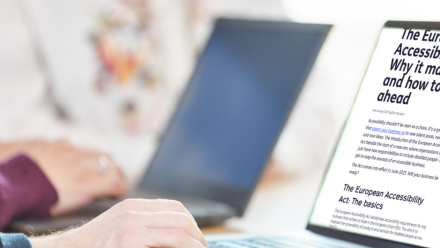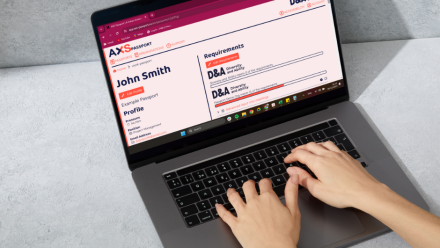What adjustments make a workplace more physically inclusive?
28th October 2024 by Scarlett James

Are you trying to get your team back in the office?
We’re sure you already know the case for remote work – it’s flexible, inclusive, and often more accessible for many. However, we recognise that working from the office has its benefits too. Face-to-face collaboration, spontaneous idea generation, and building team culture happen more naturally in person.
But everyone should feel comfortable and welcome in the office before you can expect them to come in. Don’t forget that it’s your legal duty to provide reasonable adjustments. For more insight into your legal responsibility, check out our blog on reasonable adjustments.
It’s important to remember that disability intersects with other identities like race, gender, and socio-economic status. Black and Brown disabled employees, for instance, may face compounded barriers in accessing physical adjustments.
Creating a physically inclusive workplace isn’t just about disability, it has to be deployed with an understanding of intersectionality. You should ensure that all employees, regardless of their identity, can thrive in their work environment.
Just as we strive to make our communication and working practices inclusive to all, physical adjustments are vital to creating a truly inclusive workspace.
What do the stats say?
- If you run a small company with only 50 employees, statistically, 8 of those valuable workers may be excluded from day-to-day operations due to inaccessibility.
- 78% of people said they had to initiate the process of adjustments for themselves.
- 43% of organisations say the biggest barrier to accessibility is lack of ownership.
Want more business incentives to invest in inclusion? Check out our business case for EDI.
Adjustments our team recommends
Whether your team is fully remote and needs support creating an effective work setting, or you want to make the office more accessible, we’ve got some ideas:
Adjustable Desks
Adjustable desks are a go-to in the D&A office.
They allow you to switch between sitting and standing, promoting movement throughout the day. This flexibility is particularly beneficial for individuals with chronic pain or those who may struggle to maintain one position for long periods. By providing options for both seated and standing work, these desks can help improve circulation and reduce fatigue, contributing to a healthier work environment! Just remember the desk moves before adorning heavily with knick-knacks.
Pro tip: If you can’t replace your desk, you can also get a desk riser to convert your plain old desk into a swanky adjustable one!
Our Account Management Lead, Brigit Colclough, is all about her standing desk:
‘I love using a standing desk as it means I can comfortably change position throughout my day without breaking my stride! Before I had one, I was interrupting myself to stretch out when the pain got too much, but now I can adjust my desk and wiggle to my heart’s content.’
Kneeling Chair
Why reinvent the wheel when someone has already reinvented the chair? In 1979, Norwegian designer Hans Christian Mengshoel created the kneeling chair.
For those with back pain, sciatica, or limited mobility, a kneeling chair’s ergonomic design promotes an upright posture, relieving pressure on the spine and reducing discomfort.
For neurodiverse people, the chair can offer a dynamic seating option that encourages movement and helps with focus. Different seating positions also provide sensory benefits, creating a more comfortable and supportive work environment that caters to various needs. There are plenty more options for different preferred seating and desk set-ups.
Our kneeling chair connoisseur Emily Brown, People and Operations Lead, told us about her dream desk set-up:
‘My dream work desk setup would include a minimalist, curved sit-to-stand desk, a large curved monitor, and various seating options. I enjoy switching between a kneeling chair, a regular office chair, and standing, as this helps reduce backache and improve my posture. A new addition would be a walking treadmill that I could use while taking phone calls. I tend to pace often while on the phone, and walking alleviates stress and helps me focus.’
Dimmable/ Soft Lighting
Many of us know the horror of ‘The Big Light’.
Office spaces are often worse with long fluorescent light bulbs. Dimmable lighting can reduce barriers for those with low vision or sensitivity to bright lights. It’s a small change that can make a big difference. Dimmable lights let people adjust the lighting to reduce eye strain and create a more comfortable space.
For neurodiverse folks, controlling the brightness can help manage sensory overload and improve focus. Offering flexible lighting options means you’re creating a workspace that’s more adaptable and inclusive for everyone – a win for comfort and productivity!
In a rented office building? Time to get creative, then!
Try new bulbs or a lamp set-up. The bright lights in our rented office space had a tangible impact on our team. We petitioned the office managers to switch to more energy-efficient (and less aggressive) bulbs. In the meantime, we invested in some free-standing desk lamps to immediately turn off those fluorescent bulbs.
Charlie Wood, our Head of Account Management, says:
‘I, for one, am a huge fan of soft lighting and clear signage. Soft lighting helps reduce my eye strain and the risk of migraines. Good signage helps me to navigate spaces, especially if they’re new and busy, without feeling lost or overwhelmed.’
Clear Signage
This one might seem obvious, but often, we see organisations trying to overcomplicate signage (think about those awful bathroom signs you sometimes see!).

An example of awful signage!
Don’t try to over-brand or make jokes on your signage. Stick to high contrast, clear fonts, and simple language. You’ll include disabled people, people who’ve forgotten their glasses, and non-native English speakers. It’s a no-brainer!
Clear signage is especially important when considering spaces that the public interacts with. Imagine being in an emergency at a hospital and not knowing where to go. If you can’t locate something in a shop, you won’t buy it. User outcomes are determined by their ability to access your products and services; 75% of Disabled people and their families have walked away from a business because of poor accessibility or customer service.
So don’t make it hard!
Desk Fan
A desk fan might sound basic, but it can make a real difference for people with mobility barriers or chronic health conditions.
It’s also great for managing menopause symptoms like hot flashes. And for neurodiverse individuals or those with sensory sensitivities, it helps keep the temperature comfortable and the environment manageable. It’s such a simple, practical way to improve comfort.
Our Head of Communications, Ellie Thompson, has a desk fan that is envied in our office, she had this to say about it:
“Honestly, when I realised that a desk fan could be considered a disability-related adjustment, it was a game-changer. I’ve always struggled with temperature regulation because of my health conditions, and it’s extra tough when it’s exacerbated by ADHD sensory stress! My temperature control isn’t the same as my colleagues, so I used to suffer in silence before I realised that having my own tiny fan would help me cool down without bothering anyone else.”
This isn’t guesswork, but it’s not rocket science, either. As a lived-experience led team, we can bridge any skill gaps within your team to improve your physical spaces.
Get started now by speaking to our team.


